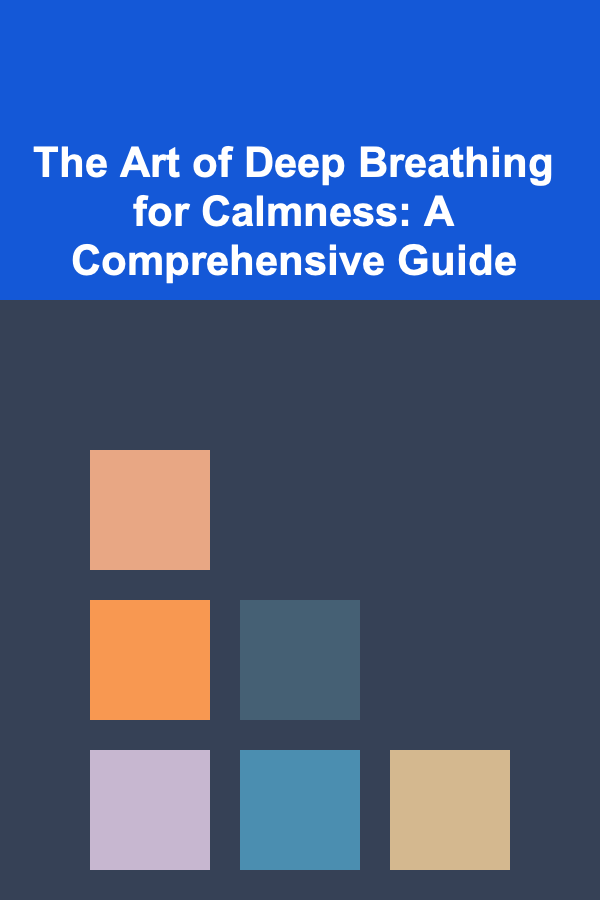
The Art of Deep Breathing for Calmness: A Comprehensive Guide
ebook include PDF & Audio bundle (Micro Guide)
$12.99$5.99
Limited Time Offer! Order within the next:

In today's fast-paced and often stressful world, finding moments of calm can feel like a luxury. However, the ability to manage stress and cultivate a sense of inner peace is crucial for both physical and mental well-being. One of the most accessible and powerful tools for achieving this is deep breathing. This comprehensive guide explores the science behind deep breathing, its benefits, and practical techniques for incorporating it into your daily life.
The Science Behind Deep Breathing
Deep breathing isn't just a folk remedy; it's a scientifically proven technique that directly impacts your nervous system. To understand how it works, we need to delve into the workings of the autonomic nervous system (ANS).
The ANS controls involuntary bodily functions such as heart rate, digestion, and breathing. It has two main branches:
- The Sympathetic Nervous System (SNS): Often called the "fight-or-flight" response, the SNS is activated during stress. It increases heart rate, blood pressure, and breathing rate, preparing the body to react to a perceived threat. Chronic activation of the SNS can lead to anxiety, burnout, and other health problems.
- The Parasympathetic Nervous System (PNS): Known as the "rest-and-digest" system, the PNS promotes relaxation, slows heart rate, lowers blood pressure, and aids digestion. It helps the body conserve energy and recover from stress.
When you practice deep breathing, you consciously influence the ANS, shifting the balance from the SNS to the PNS. Here's how:
- Stimulation of the Vagus Nerve: Deep breathing stimulates the vagus nerve, the longest cranial nerve in the body. The vagus nerve plays a crucial role in the parasympathetic nervous system. Stimulating it through deep breathing can lower heart rate, blood pressure, and promote feelings of calmness and relaxation.
- Increased Oxygen Intake: Deep breaths allow for a greater exchange of oxygen and carbon dioxide in the lungs. This increased oxygenation nourishes the brain and body, contributing to improved mental clarity and reduced fatigue. It also allows the body to more efficiently remove waste products.
- Diaphragmatic Breathing: Deep breathing encourages diaphragmatic breathing, also known as belly breathing. This type of breathing engages the diaphragm, a large muscle located at the base of the lungs. When the diaphragm contracts and moves downward, it creates space in the chest cavity, allowing the lungs to fully expand. This fuller expansion enhances oxygen intake and stimulates the vagus nerve more effectively than shallow chest breathing.
In essence, deep breathing acts as a natural tranquilizer, helping you to override the stress response and activate your body's innate relaxation mechanisms.
The Benefits of Deep Breathing
The benefits of regular deep breathing practice extend far beyond simply feeling calmer in the moment. Consistent practice can lead to significant improvements in both physical and mental health.
- Reduced Stress and Anxiety: This is perhaps the most well-known benefit. Deep breathing helps to downregulate the SNS, reducing levels of stress hormones like cortisol and adrenaline. This leads to a decrease in anxiety symptoms, such as racing thoughts, muscle tension, and rapid heartbeat.
- Lower Blood Pressure: Deep breathing can help lower blood pressure by promoting relaxation and vasodilation (widening of blood vessels). Regular practice can contribute to long-term cardiovascular health.
- Improved Sleep Quality: Practicing deep breathing before bed can calm the mind and relax the body, making it easier to fall asleep and stay asleep. It can be a valuable tool for managing insomnia.
- Enhanced Focus and Concentration: By increasing oxygen flow to the brain and reducing mental clutter, deep breathing can improve focus, concentration, and cognitive performance. It can be particularly helpful before tasks requiring mental acuity.
- Pain Management: Deep breathing can help manage chronic pain by reducing muscle tension, promoting relaxation, and distracting from pain sensations. It can be used as a complementary therapy for conditions like fibromyalgia and arthritis.
- Improved Digestion: The parasympathetic nervous system plays a crucial role in digestion. Deep breathing activates the PNS, promoting healthy digestive function and reducing symptoms of indigestion, bloating, and constipation.
- Increased Energy Levels: By improving oxygenation and reducing stress, deep breathing can combat fatigue and increase energy levels throughout the day.
- Emotional Regulation: Deep breathing practices can also increase awareness of bodily sensations and emotional states. This heightened awareness can help individuals identify and manage difficult emotions more effectively, fostering emotional resilience.
Deep Breathing Techniques: A Practical Guide
There are numerous deep breathing techniques, each with its own variations and focus. Experiment with different techniques to find the ones that resonate best with you.
1. Diaphragmatic Breathing (Belly Breathing)
This is the foundational deep breathing technique, emphasizing the use of the diaphragm.
- Find a Comfortable Position: You can lie down on your back with your knees bent, sit in a chair with your feet flat on the floor, or stand with your feet shoulder-width apart. The key is to be relaxed and comfortable.
- Place Your Hands: Place one hand on your chest and the other on your abdomen, just below your ribcage. This will help you feel the movement of your diaphragm.
- Inhale Slowly Through Your Nose: Focus on expanding your abdomen as you inhale. The hand on your abdomen should rise, while the hand on your chest should remain relatively still. Imagine you're filling your belly with air like a balloon.
- Exhale Slowly Through Your Mouth: Purse your lips slightly and exhale slowly and completely, allowing your abdomen to fall. The hand on your abdomen should move downward. Gently contract your abdominal muscles to push out any remaining air.
- Repeat: Continue breathing deeply and slowly, focusing on the movement of your diaphragm. Aim for 6-10 breaths per minute.
Practice this technique for 5-10 minutes at a time, several times a day. You can do it anywhere, anytime you need to relax and de-stress.
2. 4-7-8 Breathing Technique
Developed by Dr. Andrew Weil, this technique is particularly effective for promoting relaxation and improving sleep.
- Find a Comfortable Position: Sit or lie down comfortably.
- Exhale Completely: Exhale completely through your mouth, making a whooshing sound.
- Close Your Mouth and Inhale Quietly: Inhale deeply through your nose for a count of 4.
- Hold Your Breath: Hold your breath for a count of 7.
- Exhale Completely Through Your Mouth: Exhale completely through your mouth, making a whooshing sound, for a count of 8.
- Repeat: This is one breath. Repeat the cycle 3 more times for a total of 4 breaths.
It's important to maintain the ratio of 4-7-8. Don't worry about the speed; focus on the counts. Beginners may find it challenging to hold their breath for a count of 7. If this is the case, start with a shorter hold and gradually increase the duration as you become more comfortable. Avoid doing more than 4 breaths in the beginning until you get used to the technique. You can gradually increase to 8 breaths as you progress.
3. Box Breathing (Square Breathing)
This technique is used by Navy SEALs to manage stress and maintain focus in high-pressure situations.
- Find a Comfortable Position: Sit comfortably with your back straight.
- Exhale Completely: Exhale all the air from your lungs.
- Inhale Slowly: Inhale slowly and deeply through your nose for a count of 4.
- Hold Your Breath: Hold your breath for a count of 4.
- Exhale Slowly: Exhale slowly and completely through your mouth for a count of 4.
- Hold Your Breath: Hold your breath for a count of 4.
- Repeat: Repeat the cycle for several minutes.
Visualize a square as you practice this technique. Each side of the square represents one of the four phases: inhale, hold, exhale, hold. This visualization can help you maintain focus and rhythm.
4. Alternate Nostril Breathing (Nadi Shodhana Pranayama)
This yoga breathing technique helps to balance the energy flow in the body and calm the mind.
- Find a Comfortable Position: Sit comfortably with your spine straight.
- Close Your Right Nostril: Use your right thumb to gently close your right nostril.
- Inhale Through Your Left Nostril: Inhale slowly and deeply through your left nostril.
- Close Your Left Nostril and Open Your Right Nostril: Release your right nostril and use your right ring finger to gently close your left nostril.
- Exhale Through Your Right Nostril: Exhale slowly and completely through your right nostril.
- Inhale Through Your Right Nostril: Inhale slowly and deeply through your right nostril.
- Close Your Right Nostril and Open Your Left Nostril: Release your left nostril and use your right thumb to gently close your right nostril.
- Exhale Through Your Left Nostril: Exhale slowly and completely through your left nostril.
- Repeat: This completes one cycle. Continue alternating nostrils for 5-10 minutes.
Be gentle with your nostrils. Avoid applying too much pressure. If you have a cold or sinus congestion, avoid this technique until you feel better. Start slowly and gradually increase the duration as you become more comfortable.
5. Lion's Breath (Simhasana Pranayama)
While less subtle than other techniques, Lion's Breath can be a powerful way to release tension and energize the body. It involves a strong exhalation and facial expression.
- Find a Comfortable Position: Sit comfortably on your heels (Vajrasana) or in a cross-legged position. You can also stand with your hands on your knees.
- Inhale Deeply: Inhale deeply through your nose.
- Exhale Forcefully: Open your mouth wide and stick your tongue out towards your chin. Exhale forcefully through your mouth, making a "haaa" sound. Simultaneously, widen your eyes and tense your facial muscles.
- Repeat: Repeat this 5-7 times.
Lion's Breath is great for releasing pent-up emotions and relieving tension in the face and jaw. It's a fun and energizing breath. Be mindful of your surroundings as the exhale is quite loud.
Tips for Integrating Deep Breathing into Your Daily Life
The key to reaping the benefits of deep breathing is to make it a regular practice. Here are some tips for integrating it into your daily routine:
- Start Small: Don't try to overhaul your breathing habits overnight. Start with just a few minutes of deep breathing each day and gradually increase the duration as you become more comfortable.
- Set Reminders: Use your phone or calendar to set reminders to practice deep breathing throughout the day.
- Find Trigger Points: Identify situations that trigger stress or anxiety, such as before a meeting, during rush hour, or when you're feeling overwhelmed. Use these situations as opportunities to practice deep breathing.
- Incorporate it into Existing Routines: Combine deep breathing with other activities, such as meditation, yoga, or exercise.
- Create a Dedicated Space: Designate a quiet and comfortable space in your home where you can practice deep breathing without distractions.
- Use Guided Meditations: Numerous guided meditation apps and online resources offer deep breathing exercises and visualizations.
- Be Patient and Persistent: It may take time to develop a deep breathing habit. Don't get discouraged if you don't see results immediately. Keep practicing, and you will eventually experience the benefits.
- Practice Mindful Awareness: Pay attention to your breath throughout the day. Notice when you are breathing shallowly or holding your breath. Use these moments as reminders to take a few deep, conscious breaths.
Tip: Experiment with different environments and postures to find what works best for you. Some people find it easier to relax while lying down, while others prefer to sit or stand.
Troubleshooting Common Challenges
While deep breathing is generally safe and beneficial, some people may experience challenges when starting out.
- Feeling Lightheaded or Dizzy: This is a common side effect, especially when practicing deep breathing for the first time. It's usually caused by hyperventilation (breathing too quickly and deeply). If you feel lightheaded or dizzy, slow down your breathing and take shorter breaths. If the symptoms persist, stop the exercise and consult with a healthcare professional.
- Difficulty Concentrating: It can be challenging to focus on your breath, especially if you have a busy mind. If you find your mind wandering, gently redirect your attention back to your breath. Don't get frustrated with yourself. It's normal for the mind to wander.
- Feeling Anxious or Restless: In some cases, deep breathing can paradoxically trigger anxiety or restlessness. This may be due to underlying emotional issues or sensitivities. If you experience these symptoms, start with shorter breathing exercises and gradually increase the duration as you become more comfortable. Consider working with a therapist or counselor to address any underlying emotional issues.
- Muscle Tension: Sometimes, people inadvertently tense their muscles while trying to breathe deeply. Focus on relaxing your shoulders, neck, and jaw. Visualize releasing tension with each exhale.
Warning: If you have a pre-existing respiratory condition, such as asthma or COPD, consult with your doctor before starting deep breathing exercises. They can advise you on the appropriate techniques and precautions to take.
Advanced Techniques and Considerations
Once you've mastered the basic deep breathing techniques, you can explore more advanced practices and considerations.
- Combining Deep Breathing with Visualization: Enhance the relaxation benefits of deep breathing by combining it with visualization techniques. Imagine yourself in a peaceful and calming environment, such as a beach, forest, or mountain top. Focus on the sights, sounds, and smells of your chosen environment.
- Deep Breathing and Mindfulness Meditation: Deep breathing is often used as an anchor in mindfulness meditation. Focus on the sensation of your breath as it enters and leaves your body. When your mind wanders, gently redirect your attention back to your breath.
- Deep Breathing and Yoga: Deep breathing is an integral part of yoga practice. Synchronize your breath with your movements to deepen your stretches and promote relaxation.
- Biofeedback: Biofeedback is a technique that uses electronic sensors to monitor physiological responses, such as heart rate and muscle tension. This feedback can help you learn to control these responses through deep breathing and other relaxation techniques.
- Heart Rate Variability (HRV) Biofeedback: This specialized form of biofeedback focuses on improving heart rate variability, which is a measure of the variation in time intervals between heartbeats. Higher HRV is associated with better health and resilience. Deep breathing, guided by HRV biofeedback, can help improve vagal tone and promote overall well-being.
Conclusion: Breathe Your Way to Calm
Deep breathing is a simple yet powerful tool for cultivating calmness, managing stress, and improving overall well-being. By understanding the science behind deep breathing and practicing regularly, you can harness its transformative power and create a greater sense of peace and balance in your life. Experiment with different techniques, integrate them into your daily routine, and be patient with the process. With consistent practice, you'll discover the profound benefits of breathing your way to calm.

How to Add Curb Appeal to Your Home for a Better First Impression
Read More
How to Balance Short-Term and Long-Term Goals Effectively
Read More
How to Plan a Family-Friendly Home Party That Everyone Will Enjoy
Read More
How to Shop Smart for Home Decor on a Budget
Read More
How to Use Dividers for Privacy in Shared Rooms
Read More
How to Build a Budget-Friendly Health Planner
Read MoreOther Products

How to Add Curb Appeal to Your Home for a Better First Impression
Read More
How to Balance Short-Term and Long-Term Goals Effectively
Read More
How to Plan a Family-Friendly Home Party That Everyone Will Enjoy
Read More
How to Shop Smart for Home Decor on a Budget
Read More
How to Use Dividers for Privacy in Shared Rooms
Read More